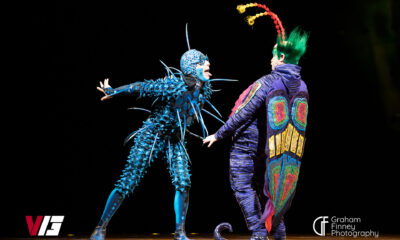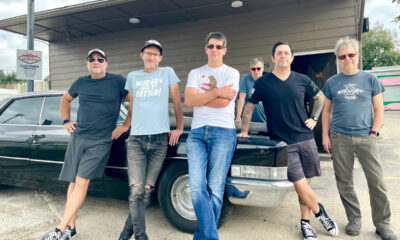Features
Women of Rock: 5 Female Musical Pioneers You Need to Know About!
With International Women’s Day just behind us, it’s time to honour our Top 5 female pioneering artists, including Poison Ivy, Suzi Quatro, Betty Davis, Goldie and The Gingerbreads and Sister Rosetta Tharpe.

Statistics show that, based on a study performed last year, the gender divide in music across regions was approximately 70 percent male and 30 percent female. Considering the sheer number of female musicians, this is a disparaging stat.
If there are thousands of women creating music every day around the world, why is it that the vast majority of them remain unknown? It’s evident that culturally, the historical accomplishments of women are not recognized in the same way that men’s are. This isn’t speculation, it’s fact. It would be easy to name the women you learned about in grade school because there were so few. From early on in music, men were being recognized, and women simply were not. Men were given the opportunity to reach great success, whereas women, were not.
As seen daily in the media, when major awards are handed out, we hear about them going to big names and forget that the bulk of the awards are given to men. At a lagging pace, sure the needle is moving, but it’s not fast enough. There’s no valid excuse for the lack of complete equality in the music industry. At this rate, it seems the most effective way for female musicians to be heard, is to give them a seat at the table, a chance to contribute and lead. Beyond that, celebrate women in music as often as possible. Additionally, honour the female trailblazers who came before them, whose stories didn’t make it into the textbooks.
In time for International Women’s Day, read on about a very small selection of female pioneers you gotta know.
01. Sister Rosetta Tharpe
(New York City, New York)
Genres: Gospel, Jazz, Blues
– There isn’t a conversation about pioneers in music, male or female, without mentioning the Mother of Rock & Roll, Sister Rosetta Tharpe, one of the most influential musicians of all time. Before there was rock & roll, there was only the blues. And blues was a kind of music that was played in the south most commonly by black men. Sister Rosetta Tharpe, a black woman in the Southern United States, was exposed to this music. Rather than continue on her gospel path, she taught herself how to play guitar and decided to create her own kind of blues.
By doing so, Tharpe, among the first recording guitarists to incorporate heavy distortion into their music, assisted in significant genre amalgamation. She pushed music forward with her unique style that refused to remain in one lane. It wasn’t gospel and it wasn’t blues, it was heavier. It would later be called rock & roll. Tharpe’s gospel song “Strange Things Happening Everyday” was the first of it’s kind to transfer into popular music. Eventually, her style influenced icons including Elvis Presley, Chuck Berry, and Johnny Cash.
You can hear the power of Tharpe’s gospel voice in this performance of “Up Above My Head.”
02. Goldie and the Gingerbreads
(New York City, New York)
Genres: Rock & Roll
– The first all-female rock band to sign to a major record label is Goldie and the Gingerbreads in 1963 when they signed with Decca. This was a precarious feat from all angles. Women, in rock music, were certainly not meant to be at the forefront. Other female rock musicians who were officially signed to record labels had to agree to a behind-the-scenes endeavour, meaning they could rarely book stage time or launch successful records. Carol MacDonald, lead guitarist of the group, was a deciding factor. The way she played her Stratocaster was so skilful, she couldn’t be ignored.
Following extensive touring and a lot of rejection (they were rarely able to headline a concert), the Gingerbreads persistence fought through the gender dynamics of the ‘60s. With difficulty, rather than go the way of most female rock musical acts at the time they (despite a short five-year run) did go on to headline stages, and share one with giants like the Rolling Stones, Animals, and Chubby Checker.
“Can’t You Hear My Heartbeat” reached No. 25 on the UK Singles Chart in 1965.
03. Betty Davis (New York City, New York)
Genres: Funk, Soul, R&B, Rock
– Primarily entering the public eye as a model in 1966, Betty Davis is a funk and soul-rock singer. Her music was most prevalent in the 1970s. There are seldom known women from that time who could command a raspy voice like Betty Davis. While it seems that Davis had a knack for downplaying her obvious strengths, attributing much of her ferocity to happenstance, she has considerable playing points. Some of which include writing songs for the Commodores, which in turn helped them sign with Motown.
Davis also played the role of a connector between huge male names in music. She did so by inadvertently becoming not only a muse but an ally to many of those men; Miles Davis, with whom she was married, Eric Clapton, Cream, Jimi Hendrix, these were the types of successful men in her orbit.
Davis is a musical powerhouse. In 1973, she released her self-titled debut album, which she wrote and produced on her own. During a period of time when it wasn’t considered a popular option for women to sing evocatively about sex in realms outside of pure rock & roll, being acutely aware of a woman’s lack of political dominance at the time, she used her power in an avenue she knew would resonate. To some success, though she was censored, she was applauded for the overt sexuality in her music, unintentionally making positive waves for the women’s rights movement at its peak. Davis’ music exudes the complexity of being a powerful, talented woman.
“Nasty Gal” from 1975 really embodies the originality and uniqueness of Davis’ sound.
04. Suzi Quatro
(Detroit, Michigan)
Genres: Rock, Hard Rock, Glam Rock
– Born into a musical family, it seems Suzi Quatro and her sisters were destined for success. A screechy-voiced bass player, technically, she wasn’t the first female punk, but she is the reason female punks were able to break through. While in high school, Quatro formed her first band, The Pleasure Seekers with her sisters, which became one of the first known all-female rock bands (one of her sisters would later go on to form all-girl band, Fanny). In the early 1970s, Quatro was spotted by British record producer, Mickie Most, who convinced her to move to London. It ended up being a wise move when she released her first single, “Rolling Stone,” a huge hit in Portugal.
After the minor success of “Rolling Stone,” in 1973 she released “Can The Can” and that one party tune changed everything. It was a clear international hit which solidified Quatro as the biggest glam star in Europe. America wasn’t as interested (or ready) for a woman to fill this role reserved for the likes of David Bowie and T. Rex, so, Quatro embraced life in London. She never slowed down, she rode waves of musicality and used her prowess to explore stage and television acting on television shows such as Happy Days and then eventually going on to host her own radio show.
Here’s a live music video of Quatro performing her massively successful “Can The Can.”
05. Poison Ivy (San Bernadino, California)
Genres: Punk, Psychobilly, Rock
– Kristy Wallace, who would eventually be known as Poison Ivy formed punk band, The Cramps in 1976 with her partner in music and love, Lux Interior, which was among the first wave of punk bands. Poison Ivy played a significant role in not only shaping punk, but spearheading the creation of punk sub-cultures including garage-punk, psychobilly, and modern surf-rock. Her guitar playing shaped the Cramps’ sound, giving them clout, especially in New York where they were a vital part of the CBGB movement.
The Cramps, under Poison Ivy’s tutelage, were able to set themselves apart by diving into the darker elements of ‘50s culture. They lured people in with horror imagery and the dangerous aspect of playing “the Devil’s music.” The Cramps were impossible to ignore because of the invigorated way they combined rock, country, blues, ultimately to form a new kind of rockabilly-infused punk. No one was genre blending in punk quite like they were at the time. The Cramps, basically managed by Poison Ivy, went on to morph their style over their many years run eventually ending when Lux passed away in 2009.
“Human Fly” is one of The Cramps’ most well-known and well-liked songs.
-

 Music3 days ago
Music3 days agoTake That (w/ Olly Murs) Kick Off Four-Night Leeds Stint with Hit-Laden Spectacular [Photos]
-

 Alternative/Rock4 days ago
Alternative/Rock4 days agoThe V13 Fix #010 w/ High on Fire, NOFX, My Dying Bride and more
-

 Hardcore/Punk2 weeks ago
Hardcore/Punk2 weeks agoHastings Beat Punks Kid Kapichi Vent Their Frustrations at Leeds Beckett University [Photos]
-

 Culture2 weeks ago
Culture2 weeks agoCirque Du Soleil OVO Takes Leeds Fans on a Unique, Unforgettable Journey [Photos]
-

 Alternative/Rock1 week ago
Alternative/Rock1 week agoA Rejuvenated Dream State are ‘Still Dreaming’ as They Bounce Into Manchester YES [Photos]
-

 Features3 days ago
Features3 days agoTour Diary: Gen & The Degenerates Party Their Way Across America
-

 Culture6 days ago
Culture6 days agoDan Carter & George Miller Chat Foodinati Live, Heavy Metal Charities and Pre-Gig Meals
-

 Music5 days ago
Music5 days agoReclusive Producer Stumbleine Premieres Beat-Driven New Single “Cinderhaze”
















